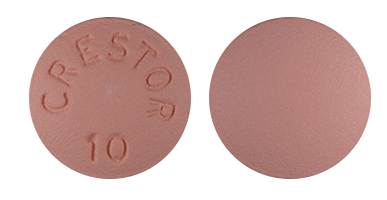Crestor Side Effects
Crestor’s three most common side effects are headaches, abdominal pain and nausea. Serious side effects may include an increased risk of diabetes and liver damage, with warnings about the risk of rhabdomyolysis (muscle degeneration) and muscle injuries.
Article Continues Below

Board-certified physicians medically review Drugwatch.com content to ensure its accuracy and quality.
Drugwatch.com partners with Physicians’ Review Network Inc. to enlist specialists. PRN is a nationally recognized leader in providing independent medical reviews.
Reviewer specialties include internal medicine, gastroenterology, oncology, orthopedic surgery and psychiatry.
Drugwatch.com has been empowering patients for more than a decade
Drugwatch.com has provided reliable, trusted information about medications, medical devices and general health since 2008. We’ve also connected thousands of people injured by drugs and medical devices with top-ranked national law firms to take action against negligent corporations.
Our team includes experienced medical writers, award-winning journalists, researchers and certified medical and legal experts. Drugwatch.com is HONCode (Health On the Net Foundation) certified. This means the high-quality information we provide comes from credible sources, such as peer-reviewed medical journals and expert interviews.
The information on Drugwatch.com has been medically and legally reviewed by more than 30 expert contributors, including doctors, pharmacists, lawyers, patient advocates and other health care professionals. Our writers are members of professional associations, including American Medical Writers Association, American Bar Association, The Alliance of Professional Health Advocates and International Society for Medical Publication Professionals.
About Drugwatch.com
- Assisting patients and their families since 2008.
- Helped more than 12,000 people find legal help.
- A+ rating from the Better Business Bureau.
- 5-star reviewed medical and legal information site.
Testimonials
"Drugwatch opened my eyes to the realities of big pharmacy. Having a family member with major depression and anxiety, I was looking for information on her medications. I found information that was very helpful, that her psychiatrist never told her."
- Common Side Effects
- Abdominal pain, constipation, dizziness, memory loss and confusion, muscle aches and pains, nausea, protein in urine, weakness and headaches
- Serious Side Effects
- Cognitive impairment, hemorrhagic stroke, increased risk of type 2 diabetes, liver damage and myopathy and rhabdomyolysis (muscle damage)
- Boxed Warning
- Crestor carries a warning about the risk of rhabdomyolysis and other muscle injuries.
Latest Crestor Side Effects Information
As of July 30, 2024, the most reported side effect of Crestor (rosuvastatin) is myalgia, also known as muscle pain, according to the U.S. Food and Drug Administration. Myalgia is a common medical condition ranging from mildly annoying to debilitating. It can feel like a deep, steady ache or sharp pain and can affect muscles, ligaments, tendons and fascia. Fascia is the connective tissue between the muscles.
According to Dr. Kevin Huffman, a board-certified bariatric physician and CEO of Ambari Nutrition, serious side effects include muscle weakness (myopathy) and muscle breakdown (rhabdomyolysis).
| FDA Adverse Event Reports for Crestor Side Effects | |
|---|---|
| Total cases reported | 43,076 |
| Serious cases (including deaths) | 25,078 |
| Deaths | 1,318 |
Disclaimer: Reports sent to the FDA don’t necessarily mean the drug caused an adverse event. Consult a health care professional before stopping or changing medication.
Huffman said that as far back as 2013, a study published in the Journal of the American College of Cardiology found a ‘concerted’ increase in the risk of myopathy among statin patients taking higher doses.
“It’s not controversial that higher doses of rosuvastatin, Crestor’s active ingredient, are associated with these risks,” Huffman told Drugwatch.
Despite these risks, the number of reports has been decreasing since 2013. The combined total of all FAERS reports in the last three years is only around 3.6% of all reports since 2003.
Most Recent Crestor FDA Warnings
In 2012, the FDA updated Crestor’s label to include the potential risk of rhabdomyolysis. This severe muscle condition can lead to kidney damage.
The label was also updated that year to warn of memory loss or confusion while taking the drug. Another label addition in 2012 warns that statins, the drug class Crestor belongs to, can cause hyperglycemia, which is an increase in glucose blood levels. This can increase the risk of Type 2 diabetes.
Common Side Effects of Crestor
According to Crestor’s drug label, headache is the most common side effect of Crestor in clinical trials, followed by nausea and myalgia. The following list from Crestor’s label insert shows the side effects reported during clinical trials of Crestor and the percentage of trial participants who experienced each one.
- Headaches: 5.5%
- Myalgia: 2.8%
- Abdominal pain: 2.4%
- Asthenia (weakness & fatigue): 2.7%
- Nausea: 3.4%
Most common side effects, such as headaches and abdominal pain, typically resolve within a few days to weeks as the body adjusts to the medication. Serious side effects require immediate medical attention and may persist longer, depending on the individual’s health condition and response to treatment.
While most Crestor side effects are mild, patients should still monitor and report them to a health care provider. Your provider can ensure any symptoms you experience aren’t signs of another issue.
Serious Crestor Side Effects
In rare cases, serious side effects of Crestor can include liver damage, stroke and cognitive issues. Although rare, patients should still be aware of these risks.
- Myopathy and Rhabdomyolysis
- Crestor has been linked to an increased risk of myopathy and rhabdomyolysis. Myopathy refers to a muscle disorder in which muscle fibers do not function properly, while rhabdomyolysis is a severe form of muscle damage that can lead to kidney failure. Symptoms include muscle pain, tenderness, weakness and dark urine.
- Increased Risk of Type 2 Diabetes
- Studies have shown that the statin class of drugs, which includes Crestor, can increase the risk of Type 2 diabetes. This risk appears to be dose-dependent and more significant in individuals with predisposing factors such as obesity or a family history of diabetes.
- Liver Damage
- Crestor can cause liver damage, indicated by elevated liver enzymes. This is rare but serious and requires regular liver function monitoring.
- Hemorrhagic Stroke
- While statins are effective in reducing ischemic strokes - strokes caused by a blocked vein or artery - some studies suggest they might increase the risk of hemorrhagic strokes. Internal bleeding in the brain or skull causes hemorrhagic strokes. Individuals with a history of strokes or those with low cholesterol levels are especially at risk.
- Cognitive Impairment
- There have been reports of cognitive impairment, such as memory loss and confusion, associated with statin use. These side effects are generally reversible upon discontinuation of the medication.
“Have a frank discussion with your doctor regarding your family history of Type 2 diabetes, and request regular blood sugar checks,” Huffman told Drugwatch.
Serious side effects of Crestor can have significant health impacts which require prompt medical attention and ongoing monitoring.
Crestor and Rhabdomyolysis
Several factors influence the risk of developing rhabdomyolysis from Crestor, including the dosage, the patient’s age, kidney function and concurrent use of other medications that might interact with statins. Rhabdomyolysis is a condition in which the muscles break down and these byproducts release into the bloodstream. This can potentially cause kidney damage. People over the age of 65, people with kidney issues or implants and people taking medications such as cyclosporine, atazanavir/ritonavir, lopinavir/ritonavir or simeprevir concurrently, are at a higher risk.
Notably, studies have shown that the incidence of rhabdomyolysis is higher in patients taking Crestor compared to some other statins. This elevated risk underscores the importance of careful patient selection and monitoring by health care providers.
When To Seek Medical Attention
Patients should seek immediate medical attention if they experience unexplained muscle pain, tenderness or weakness, as these could be early signs of rhabdomyolysis.
“Remedies include starting with the lowest effective dose of Crestor and having your creatine kinase altered periodically through a blood test to check for muscle damage,” Huffman said. High levels of creatine kinase – an enzyme in your blood – can indicate muscle injury as well as heart or brain damage.
Other symptoms that warrant urgent care include dark urine (which may indicate the presence of muscle breakdown products), severe abdominal pain, jaundice (yellowing of the skin or eyes) and significant changes in memory or cognitive function.
Crestor FDA Warnings and Actions
The FDA has released several warnings regarding Crestor, emphasizing the risks of muscle damage, diabetes and liver injury. Health care professionals receive regular updates and monitoring recommendations.
You can read all FDA warnings, precautions and drug interactions on the Crestor label insert.
As of July 2024, there have been no recalls for Crestor. Patients should stay informed through regular updates from the FDA and consult their health care provider with any concerns.
In 2004, Public Citizen called for the FDA to recall Crestor to prevent additional rhabdomyolysis, kidney failure and kidney damage. Although the FDA rejected the requests, the agency has mandated that AstraZeneca, the manufacturer of Crestor, include warnings on the drug’s label regarding the possibility of developing rhabdomyolysis with acute renal (kidney) failure.
How To Manage or Avoid Crestor Side Effects
Proper management of side effects involves regular monitoring, lifestyle adjustments and open communication with health care providers.
“You should monitor yourself for unexplained muscle pain, weakness, or tenderness, especially if those symptoms worsen with activity,” Huffman said. “Notify your doctor right away if you experience these symptoms.”
- Get liver function tests before and during treatment.
- Monitor blood sugar levels regularly, especially if at risk of diabetes.
- Report muscle pain or weakness right away.
- Stay hydrated and eat a balanced diet to support overall health and reduce side effects.
Whether the side effects you experience are barely noticeable or impact your day-to-day functioning, it is essential to keep your prescriber informed so they can adjust your medication if needed.
Crestor Alternatives
Patients concerned about Crestor’s side effects have several statin alternatives.
- Atorvastatin (Lipitor)
- Fluvastin (Lescol XL)
- Lovastatin (Altoprev)
- Pitavastatin (Livalo)
- Pravastatin (Pravachol)
- Simvastatin (Zocor)
Crestor, like all statins, is used to help reduce the levels of low-density lipoprotein (LDL) cholesterol and triglycerides, a type of fat, in your blood. Most statins are similar, with the main difference being the dosage and how much they lower LDL levels. Crestor and Lipitor can lower LDL levels by over 50%, which is more than any other statin.
Discussing options with a health care provider can help find a suitable replacement. Individual factors such as pre-existing health conditions, concurrent medications and specific cholesterol-lowering goals should guide the choice of therapy. Regular follow-ups and monitoring are essential to ensure the chosen medication is both effective and well-tolerated.
Editor Lindsay Donaldson contributed to this article.
Calling this number connects you with a Drugwatch.com representative. We will direct you to one of our trusted legal partners for a free case review.
Drugwatch.com's trusted legal partners support the organization's mission to keep people safe from dangerous drugs and medical devices. For more information, visit our partners page.



